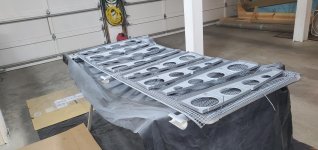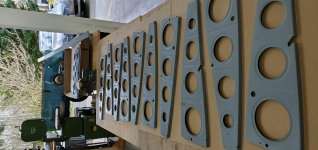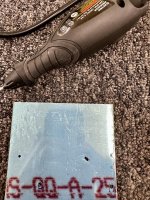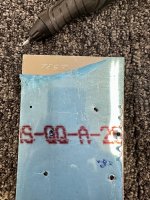The parts for my vertical and horizontal stabilizers are ready for priming and assembly. I'm planning to start with Stewart Systems water-based EkoPrime.
I have no experience using a spray gun, and it's been awhile since I've done any practice riveting, so I decided to build another practice kit (flap) to test my end-to-end process. I've been diligent about marking my parts as I go with blue Sharpie (part #s, witness marks, etc.), and was worried what would happen when I got to the priming step. Well, I found out.
I need a strategy for IDing parts that survives priming.
First, here's what I did: mark my parts; scuff for priming; re-mark my parts; clean for priming; re-mark my parts; etch for priming; re-mark my parts; solvent wipe for priming; re-mark my parts (where I could discern my old marks, anyway); spray primer; try to figure out what's what.
After spraying, I had a few parts that I could just barely make out my marks. I don't know if that was just the right amount of primer to use, or not enough. If the later, I suppose that I could add more "marking" steps between light dustings of primer, but there's gotta be a better way.
Do you have any suggestions, or pointers to suggestions?
I have no experience using a spray gun, and it's been awhile since I've done any practice riveting, so I decided to build another practice kit (flap) to test my end-to-end process. I've been diligent about marking my parts as I go with blue Sharpie (part #s, witness marks, etc.), and was worried what would happen when I got to the priming step. Well, I found out.
I need a strategy for IDing parts that survives priming.
First, here's what I did: mark my parts; scuff for priming; re-mark my parts; clean for priming; re-mark my parts; etch for priming; re-mark my parts; solvent wipe for priming; re-mark my parts (where I could discern my old marks, anyway); spray primer; try to figure out what's what.
After spraying, I had a few parts that I could just barely make out my marks. I don't know if that was just the right amount of primer to use, or not enough. If the later, I suppose that I could add more "marking" steps between light dustings of primer, but there's gotta be a better way.
Do you have any suggestions, or pointers to suggestions?








